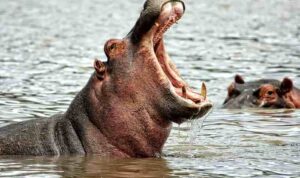Ngorongoro Crater (Tanzania) is a breathtaking marvel that boasts a unique ecosystem and rich wildlife diversity, making it a must-visit UNESCO World Heritage Site in Africa. Explore the wonders of this natural paradise with us.
The formation, wildlife, geography, and conservation efforts surrounding Ngorongoro Crater unveil a fascinating narrative waiting to be discovered.
Overview of Ngorongoro Crater

Ngorongoro Crater, located in Tanzania, is a large volcanic caldera formed around 2.5 million years ago when a massive volcano exploded and collapsed on itself, creating a unique natural amphitheater.
Formation of Ngorongoro Crater
The formation of Ngorongoro Crater began with the eruption of a volcano that eventually collapsed, forming the caldera we see today. This geological phenomenon resulted in the creation of a vast and fertile environment that supports a diverse range of flora and fauna.
Unique Ecosystem within the Crater
The Ngorongoro Crater is home to a remarkable ecosystem that includes grasslands, forests, lakes, and swamps, providing a habitat for a variety of wildlife species. The diverse landscape supports a high concentration of animals, making it a prime location for safari enthusiasts and nature lovers.
Significance as a UNESCO World Heritage Site
Ngorongoro Crater was designated as a UNESCO World Heritage Site in 1979 due to its outstanding universal value as a natural phenomenon and its importance in preserving biodiversity. The crater serves as a crucial sanctuary for endangered species like the black rhinoceros and supports the conservation efforts of various wildlife organizations.
Wildlife in Ngorongoro Crater

Ngorongoro Crater is home to a diverse array of wildlife due to its unique ecosystem and geographical features. The crater provides a protected habitat for a wide variety of animal species, making it a popular destination for wildlife enthusiasts and conservationists alike.
Different Species of Animals in Ngorongoro Crater
- Lions
- Elephants
- Buffaloes
- Leopards
- Rhinos
- Hyenas
- Wildebeests
- Zebras
- Giraffes
- Hippopotamuses
- Cheetahs
The Ngorongoro Crater is also known for its high density of predators, making it a prime location for witnessing predator-prey interactions in the wild.
Behavior of Key Wildlife Species
Many of the key wildlife species in Ngorongoro Crater exhibit fascinating behaviors that are essential for their survival in the wild. For example:
- Lions are often observed hunting in groups, showcasing their cooperative hunting strategies.
- Elephants can be seen engaging in social interactions within their herds, demonstrating strong familial bonds.
- Leopards are known for their elusive nature and exceptional climbing abilities, allowing them to ambush their prey from treetops.
Challenges Faced by Wildlife in the Crater
Despite the protected status of Ngorongoro Crater, wildlife in the area still face several challenges that threaten their survival:
- Habitat loss due to human encroachment and land use changes.
- Poaching activities targeting endangered species such as rhinos and elephants.
- Competition for resources among different animal species due to the limited space and food availability in the crater.
Geography and Geology

Ngorongoro Crater, located in Tanzania, is a large volcanic caldera formed by the collapse of a volcano millions of years ago. The crater is part of the Ngorongoro Conservation Area, a UNESCO World Heritage Site known for its stunning landscapes and diverse wildlife.
Geographical Features of Ngorongoro Crater
The Ngorongoro Crater is approximately 610 meters deep and covers an area of about 260 square kilometers. It is home to a variety of habitats, including grasslands, forests, and a soda lake. The crater walls are steep and provide a natural enclosure for the abundant wildlife within.
Volcanic History
The Ngorongoro Crater was formed around 2.5 million years ago when a large volcano erupted and collapsed on itself, creating the caldera we see today. The volcanic activity in the area has shaped the landscape and influenced the geology of the region.
Influence of Geology on the Ecosystem
The geology of the Ngorongoro Crater plays a significant role in shaping the ecosystem within it. The fertile soil and abundance of water sources support a wide variety of plant life, which in turn sustains a diverse range of wildlife. The volcanic ash and minerals in the soil provide essential nutrients for plants to grow, creating a rich and vibrant ecosystem within the crater.
Conservation Efforts: Ngorongoro Crater (Tanzania)

Conservation efforts in Ngorongoro Crater are crucial to protect the diverse ecosystem and wildlife that reside within this unique area. Various initiatives have been put in place to ensure the sustainability of the environment and the species that call it home.
Role of Local Communities
Local communities play a vital role in the conservation efforts of Ngorongoro Crater. They are actively involved in sustainable tourism practices, habitat restoration, and wildlife monitoring. By engaging with the local communities, conservationists can ensure the long-term protection of the area.
Threats to Conservation, Ngorongoro Crater (Tanzania)
- Human-wildlife conflict: As the human population grows around the crater, conflicts between humans and wildlife increase, leading to habitat destruction and endangering species.
- Poaching: Illegal poaching of wildlife for their horns, tusks, or skins remains a significant threat to the conservation of Ngorongoro Crater.
- Invasive species: The introduction of invasive plant species can disrupt the natural balance of the ecosystem and threaten the survival of native flora and fauna.
- Climate change: Changing weather patterns and temperatures can have a profound impact on the ecosystem of Ngorongoro Crater, affecting both plant and animal species.
In conclusion, Ngorongoro Crater stands as a testament to nature’s beauty and resilience, captivating visitors with its unmatched charm and significance. Plan your trip to this remarkable destination and witness the wonders of the crater firsthand.






